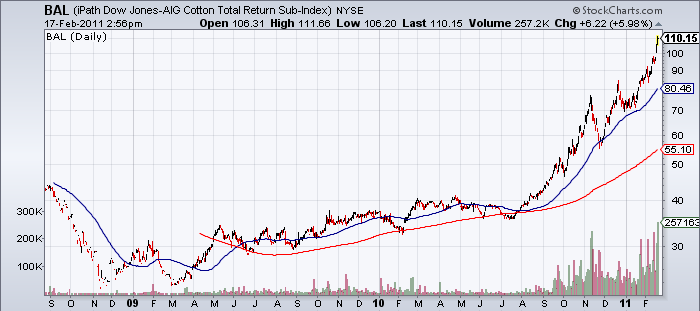The Fed has not been shy about taking credit for the recent equity price increases. They claim that this so-called “wealth effect” will spill over into the real economy and create a “virtuous cycle” where nominal wealth creation leads to real wealth creation (they have that part backwards – real wealth creation leads to nominal wealth creation, but who needs facts anymore?). But the Fed has also been quick to claim no part in the recent commodity price spike (also no mention of the continuing house price declines, but again, who needs all the facts when you can better prove your point by leaving most of the facts out of the equation?).
I have claimed that the Bernanke Put is a direct cause of a severe psychological imbalance in the market where investors begin to act irrationally based on false promises made by the Fed. The truth is, the Fed’s ability to influence the real fundamental economy via QE is limited (this has become abundantly clear when one actually studies the intended transmission mechanisms of QE), however, they are having a powerful impact on market psychology. This is where many economists lose sight of the forest for the trees. They entirely ignore the human reaction to policy measures. And in an environment where the Fed is maintaining low rates and literally telling people that they will keep “asset prices higher than they otherwise would be” it is simply foolish to believe that they are not inducing some level of speculation in various markets.
The recent bout of inflation in China and the floods in Australia have laid the perfect foundation for a fundamentally driven rally in many commodities. Add in the Fed’s direct message to buy risk assets and you have all the ingredients for rampant speculation. To believe that this speculation is stopping at equities is naive at best. The fundamental story in the emerging markets and hence the commodity markets is far superior to the modest growth story in most US equities. So, it’s only natural so see investors pouring into the commodity markets with the expectations of higher gains on the misconception of the Fed’s “money printing” and a sound fundamental backdrop.
The problem is, investors and speculators are taking the Fed’s words to heart and they are acting on them. This remarkable video from Bloomberg (via Ed Harrison at Credit Writedowns) proves that speculators are in fact hoarding commodities. It’s no secret that the Chinese believe the USA is largely causing their inflation problems via QE. They’ve responded with their own Quantitative Tightening. And while the fundamental story behind the Fed’s actions holds little water there is a dramatic and meaningful psychological impact and we are seeing it in real-time with our own two eyes (yes, that is a pile of cotton that a Chinese speculator is hoarding in his living room).
Quantitative Easing was never necessary to begin with. The Fed panicked over the summer of 2010 due to a few negative data points and now they are attempting to justify a severe policy mistake rather than simply admitting wrong and removing the destructive Bernanke Put. Recent market data proves that QE is nowhere close to achieving the goals it was initially set out to meet. And now there is clear cut evidence that it is having a disastrous impact on the marketplace by causing severe instability in commodity prices. It’s not merely coincidence that signs of this speculation began in August when the Fed initiated its “money printing” program.

(cotton prices have more than doubled in 6 months)
It’s time for the Fed to take responsibility not only for the equity rally, but also the rise in commodity prices. Perhaps more importantly, it is time for the Fed to admit that it is having a highly destructive impact on market psychology and is only helping to fuel a speculative frenzy that is likely to increase price instability and market disequilibrium.
QE has failed to generate any sort of job growth in the USA. There are now signs that it is creating severe price instability in many markets. Therefore this policy measure is counterproductive to both of the Fed’s mandates. It’s time to reconsider Fed policy and whether this approach is appropriate in the current environment. To me, it is clear that it is not.
Mr. Roche is the Founder and Chief Investment Officer of Discipline Funds.Discipline Funds is a low fee financial advisory firm with a focus on helping people be more disciplined with their finances.
He is also the author of Pragmatic Capitalism: What Every Investor Needs to Understand About Money and Finance, Understanding the Modern Monetary System and Understanding Modern Portfolio Construction.

Comments are closed.